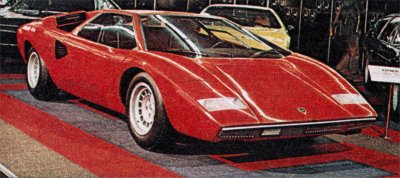Description
The Lamborghini Countach LP 500 was the extraordinary prototype that changed the direction of supercar design forever. Revealed at the 1971 Geneva Motor Show, it was not merely a concept car but a full-scale, running vision of the future—a radical blend of technology, proportion, and geometry that would define Lamborghini’s design language for decades to come. The LP 500 introduced the world to the Countach name and marked the beginning of an icon that would go on to become one of the most famous supercars ever built.
The Countach LP 500 emerged during Lamborghini’s most creative and daring period. After the success of the Miura, Ferruccio Lamborghini sought a successor that would push engineering and design to an entirely new level. The project, internally coded LP 112, was led by chief engineer Paolo Stanzani, with Gian Paolo Dallara contributing early structural concepts and Bob Wallace overseeing development. The exterior was entrusted to Marcello Gandini at Carrozzeria Bertone, whose angular, geometric design would set a new benchmark for modern automotive form.
The name “Countach” came from a Piedmontese expression of astonishment—an exclamation equivalent to “Wow!”—and it perfectly captured the public’s reaction when the LP 500 was unveiled. Painted in a luminous yellow and displayed under bright lights in Geneva, the car looked like nothing else on the planet. The sharp wedge profile, the scissor-style doors, and the impossibly low roofline were pure theatre, but they also embodied Gandini’s obsession with function expressed through form. Every line was purposeful, every angle part of a coherent sculptural vision. The car’s wedge shape, accentuated by a pointed nose and tapering tail, created an impression of motion even when standing still.
The designation LP 500 referred to the prototype’s longitudinally mounted posterior 5.0-litre engine—a configuration that became a defining element of Lamborghini design. The 4,971 cc V12 was derived from the Miura’s powerplant but re-engineered to sit lengthwise behind the cabin rather than transversely. This arrangement improved cooling, weight distribution, and serviceability while allowing the gearbox to be mounted ahead of the engine, connected by a driveshaft running beneath the sump. Power output was estimated at around 440 horsepower, giving the LP 500 theoretical performance figures beyond anything else on the road.
The chassis of the LP 500 was a completely new design. It used a semi-monocoque steel frame that combined a central structural tub with tubular front and rear sections to support the suspension and drivetrain. The layout was lighter and stiffer than the Miura’s, improving handling and rigidity. The suspension used unequal-length wishbones and coil springs at all four corners, while the wheels were cast magnesium Campagnolo alloys fitted with wide tyres that filled the sharply cut wheel arches. The car’s overall height was just over one metre, giving it an extreme stance that seemed almost impossible for a road car.
The interior of the prototype was equally futuristic. The cabin was low and compact, with deep-set bucket seats and a wide, angular dashboard that wrapped around the driver. The gear lever rose from a narrow central console, while the steering wheel was small and steeply raked. Visibility was limited, but the cockpit conveyed the sense of sitting inside a spacecraft—precise, mechanical, and utterly immersive. Gandini’s use of geometric shapes extended even to the interior surfaces, creating a unified design that felt ahead of its time.
The LP 500 was a fully functional prototype, tested extensively by Bob Wallace at Lamborghini’s factory and on Italian roads. However, its 5.0-litre engine proved temperamental, with overheating and reliability issues that made it unsuitable for production. When the production Countach LP 400 debuted in 1974, it featured a smaller 3.9-litre V12 and a modified chassis, but the visual design remained remarkably faithful to the LP 500’s form—a testament to how advanced the prototype had been.
Unfortunately, the original LP 500 did not survive. In 1974, Lamborghini sacrificed the prototype during crash testing at the request of Italian authorities, as part of the homologation process for the Countach LP 400. Despite its destruction, its influence endured, not only in Lamborghini’s subsequent models but across the entire automotive industry. The Countach introduced a new design language—the angular “wedge” aesthetic—that inspired generations of supercars and redefined what a performance car could look like.
Decades later, the legend of the LP 500 grew, and in 2021 Lamborghini announced a remarkable project: the complete reconstruction of the Countach LP 500 prototype. Using original drawings, period photographs, and surviving mechanical data, the company’s Polo Storico division recreated the car in meticulous detail over 25,000 hours of work. The reborn LP 500, painted in its original Giallo Fly Speciale, served as both a tribute to the genius of Gandini and a celebration of Lamborghini’s heritage of innovation.
The Lamborghini Countach LP 500 was more than a concept—it was a revolution in metal and glass. It marked the transition from the sensual forms of the 1960s to the geometric boldness of the 1970s, and in doing so, it defined the supercar as an object of art, power, and imagination. Though the prototype itself was lost, its spirit became immortal, living on in every Countach that followed and in the DNA of Lamborghini’s design philosophy to this day.

